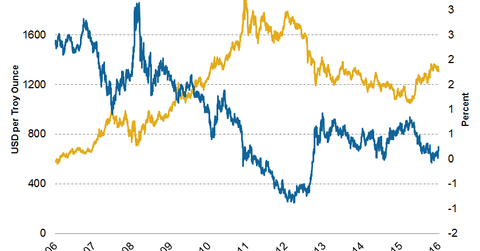Gold versus 10-Year Treasury Bonds
The negative interest policy of the central banks is casting government bonds as a futile choice for investors compared to stocks and gold. As a result, bond prices dipped and yields started rising.
Dec. 2 2019, Updated 9:47 a.m. ET

While investors appear more convinced that the Federal Reserve (or Fed) will indeed hike rates later this year, real yields remain well below where they started the year and even further below their long-term average.
From my perspective, with volatility unsustainably low, I would be reluctant to abandon the asset class.
Since my last blog post on gold, the precious metal has climbed over 8% from its May lows, although it lost considerable ground in August (source: Bloomberg data). Back in May, my main argument in favor of gold was a benign monetary regime, i.e. low to negative real rates, or interest rates after inflation. And when rates are low (or negative), there is no opportunity cost in holding gold.
Market Realist – How did the ten-year Treasury bond yields perform?
The negative interest policy of the central banks is casting government bonds as a futile choice for investors compared to stocks and gold. As a result, bond prices dipped and yields started rising.
In 2008, we saw the ten-year Treasury note yield dip from ~4% to the plus-2% range. This movement resulted from the increase in the price of the popular and safe Treasury bonds compared to stocks and quantitative easing in the US. However, the yields rebounded and ended in the ~4% range in 2009. However, 2010 witnessed a fall in yields but ended at the plus-3% range.
In 2011, the yield started dipping and ended below 2% due to quantitative easing in the US. The rates fell further in 2012 and ended at 1.8% due to the European financial crisis and quantitative easing in the US. Yields grew in 2013 and ended the year at 3%.
However, 2014 witnessed a drop in yields, but they ended the year at 2.2%. The yield remained in almost the same position at the end of 2015—2.3%. The improved yields in 2014 and 2015 reflected the recovery of the Eurozone economies and a potential hike in the Fed rate.
The ten-year inflation-indexed Treasury rate is a proxy for US long-term real interest rates. The yield on the ten-year Treasury note (TMUBMUSD10Y) fell 24.1% YTD to 1.7% on September 16, 2016, akin to the 2012 levels. At the same time, the yield has increased from the 1.5%–1.6% level since the Brexit vote. The 30-year Treasury note fell 18.1% YTD to 2.4% on September 16.
The iShares 20+ Year Treasury Bond ETF (TLT), the iShares 7–10 Year Treasury Bond ETF (IEF), the iShares 1–3 Year Treasury Bond ETF (SHY), the iShares Core US Treasury Bond ETF (GOVT), and the iShares 3–7 Year Treasury Bond ETF (IEI) recorded growth of 12.3%, 5.5%, 0.9%, 3.5%, and 3.1% YTD, respectively, in 2016.
